Expert Mercedes Benz Radiator Replacement in Dubai
Noticed coolant leaks or rising engine temperature in your Mercedes? In Dubai, over 70% of overheating issues start with a faulty radiator. We offer Mercedes Benz radiator replacement in Dubai using genuine parts, correct G48 coolant, and tools made for Mercedes only. Most jobs are done in 3 to 4 hours. We work on all models C, Class, E, Class, GLE, and AMG. You get 10% off labor and a free coolant system check this week. Over 200 Mercedes owners trusted us last month. Book now before minor leaks become engine damage.
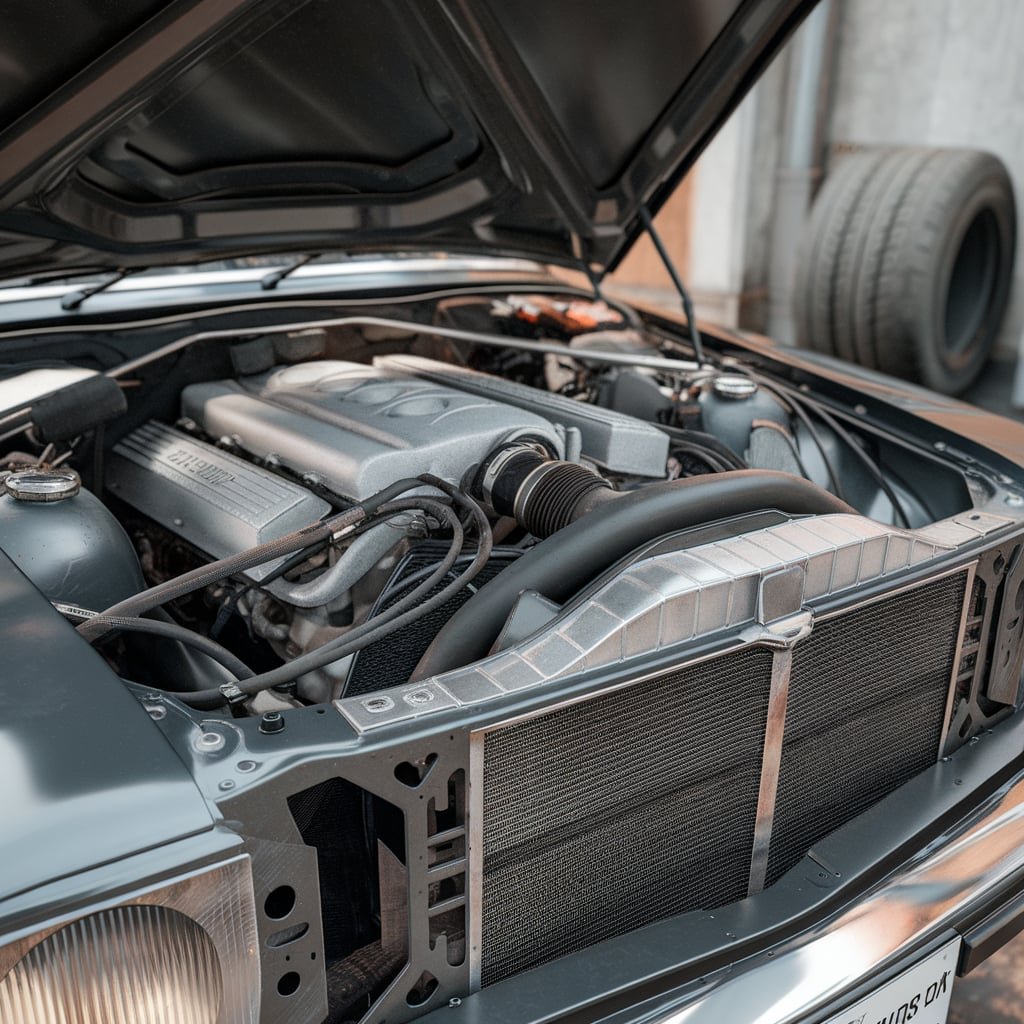
What a Radiator Does in a Mercedes Benz
The radiator in a Mercedes Benz plays a critical role in keeping the engine at the right temperature. It removes heat from the coolant that circulates through the engine block. When the engine reaches about 90°C, the thermostat opens and sends hot coolant into the radiator. There, the heat is released into the air through the radiator fins. A fan helps this process by pulling air through the radiator, especially in traffic or at low speeds. This cycle repeats constantly while driving, preventing the engine from overheating.
In many Mercedes models, especially AMG and 7G-Tronic variants, the radiator also includes a built-in transmission fluid cooler. This dual function helps protect both the engine and gearbox. The average Mercedes radiator holds between 6 to 12 liters of coolant, depending on the model. Most use the G48 Mercedes-approved coolant, which protects against corrosion and scaling. If the radiator fails or clogs, the engine can overheat in less than 10 minutes, leading to head gasket failure or even engine block damage. That is why Mercedes radiator replacement in Dubai is not just a repair—it is a safety measure.
Radiator Build Types Found in Mercedes Models
Mercedes Benz uses different radiator types depending on the model, engine, and cooling demands. Each type serves a specific purpose, some focus only on engine cooling, while others manage both engine and transmission temperatures. Knowing the correct type is important to avoid performance issues or premature part failure. Here are the common Mercedes radiator types we deal with in Dubai:
- Plastic-Aluminum Radiators
Found in most C, Class, E, Class, and older GLK models. Lightweight and cost effective, but prone to cracking over time due to Dubai’s heat. - Full-Aluminum Radiators
Installed in high performance models like AMG, S-Class, and GLE 63. Offers stronger heat control and longer durability under load. - Radiators with Integrated Transmission Coolers
Common in 7G, Tronic and 9G, Tronic automatic models. These help cool transmission oil along with engine coolant. - Multi Layer or Split Flow Radiators
Used in diesel, hybrid, or newer luxury models. Designed to manage separate heat zones within a single cooling unit.
Each radiator must match the car’s exact cooling requirements. During every Mercedes radiator replacement in Dubai, we select the correct type based on the VIN, engine code, and system design, no guesswork involved.
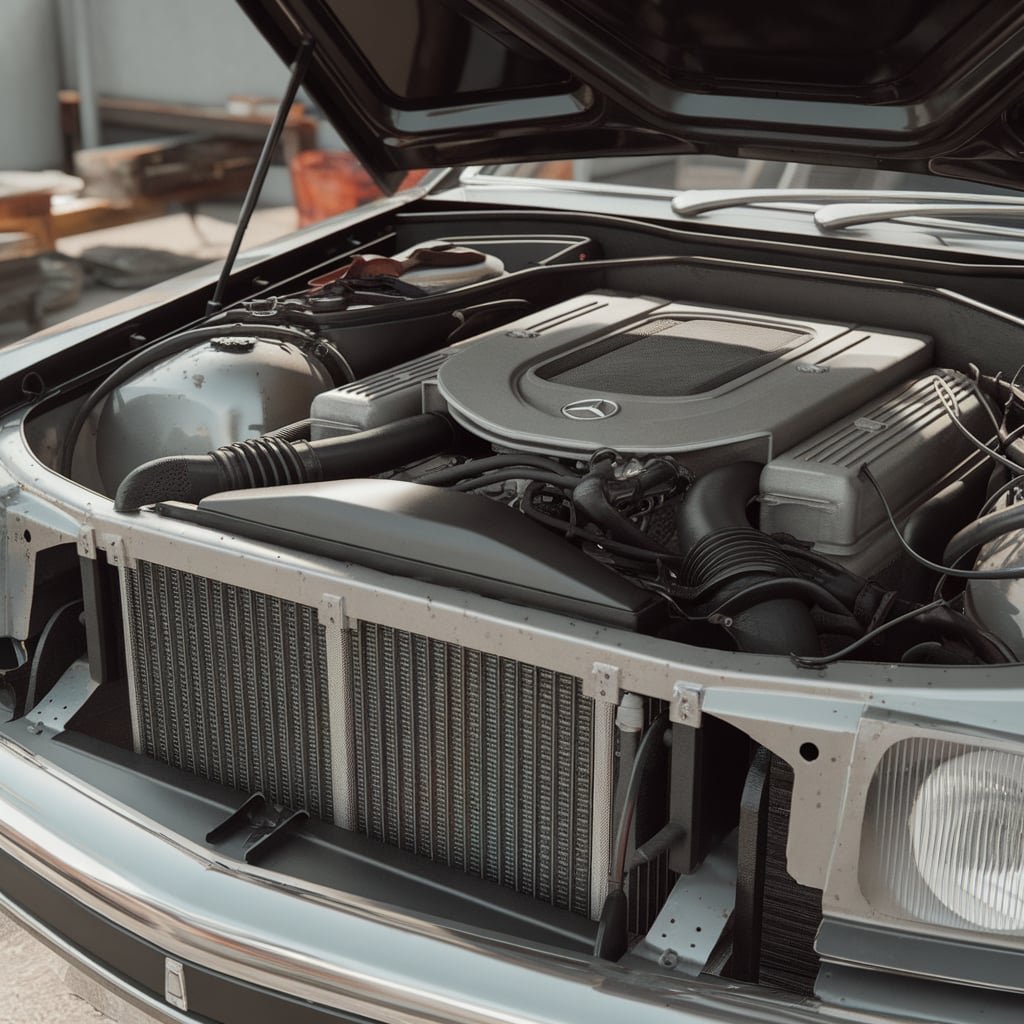
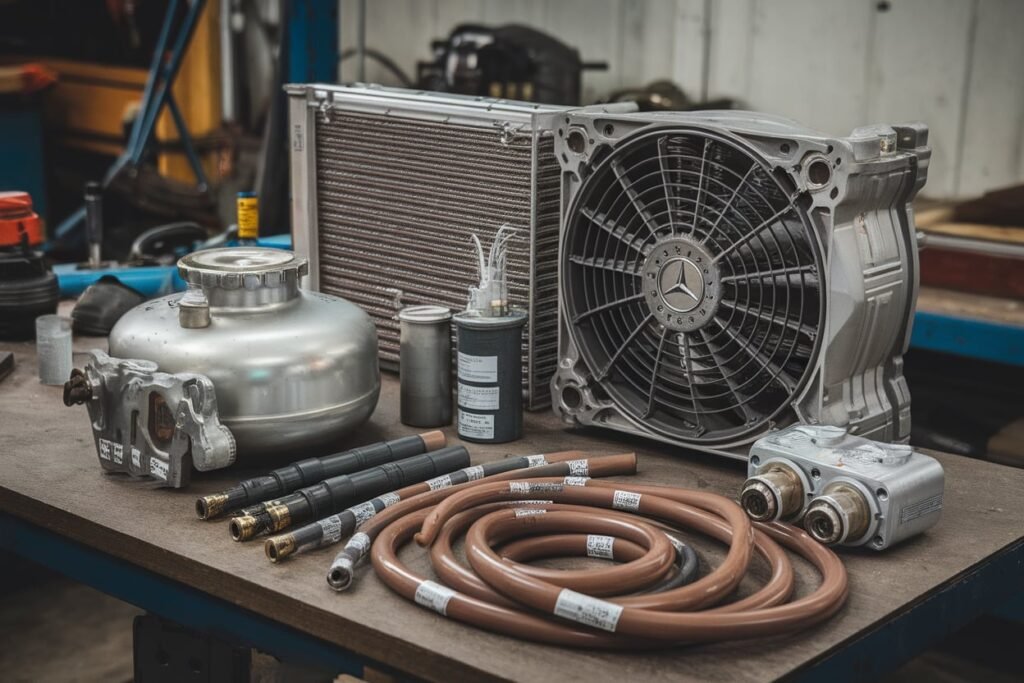
Symptoms That Indicate Radiator Replacement
A damaged radiator in a Mercedes Benz does not always show obvious signs at first. But specific symptoms can point directly to internal or external radiator failure. In Dubai, with high engine loads and frequent AC use, these signs can escalate quickly.
- Temperature Spikes Right After Start-Up
If the engine temperature jumps above 100°C within 5–10 minutes of driving, coolant is not circulating properly, often due to a blocked or internally collapsed radiator. - Coolant Overflow Without Warning Light
When coolant starts spilling out from the overflow tank without triggering a dashboard warning, it may be due to poor flow through the radiator or a cracked core. - Soft or Collapsing Upper Radiator Hose
A spongy or sucked, in hose at the top of the radiator while the engine is hot usually means the radiator is clogged or not allowing proper vacuum flow during cooling. - Oil in Coolant Reservoir (Milky Fluid)
If you notice milky, mixed fluid inside the reservoir, the radiator’s integrated oil cooler may have failed, common in 7G, Tronic models with combined cooling systems. - One Side of Radiator Hot, Other Side Cold
During idle inspection, if only one half of the radiator feels hot to the touch while the other is cold, it points to internal blockage or flow restriction. - Sudden Drop in Cabin Heater Performance
If your heater stops blowing warm air even with full coolant, the radiator may be obstructed and not allowing enough flow through the heater core circuit.
Each of these symptoms can signal a deeper issue. Our Mercedes radiator replacement in Dubai includes detailed thermal scanning, pressure checks, and flow tests to pinpoint the exact cause, no assumptions, no delays.
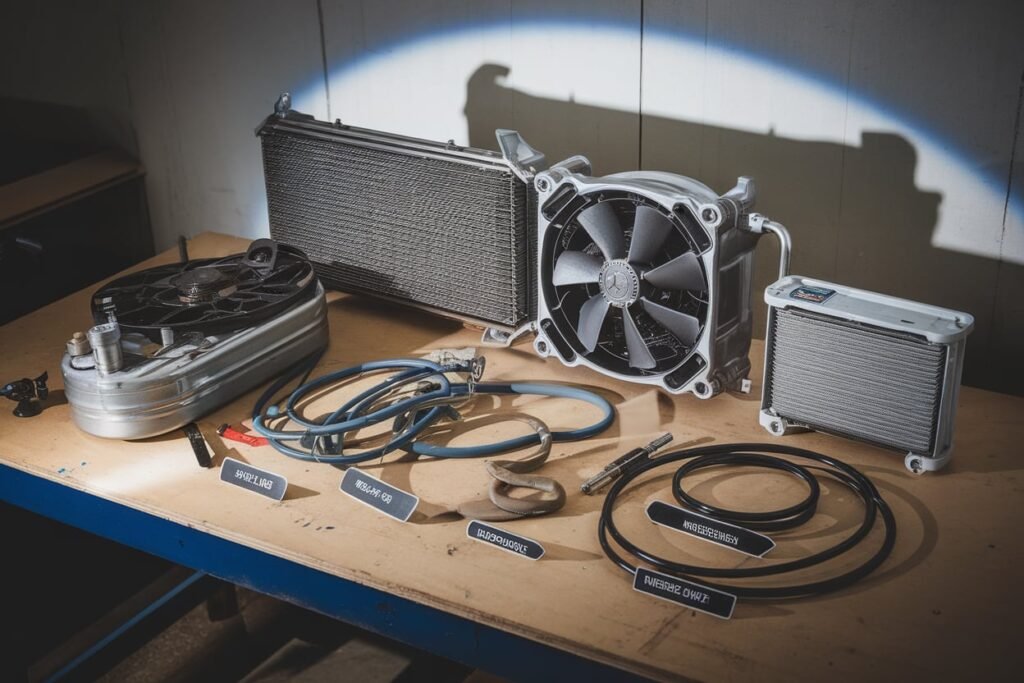
Why Radiators Fail Prematurely in Mercedes
Radiators in Mercedes Benz vehicles are built for performance, but under certain conditions, they can fail earlier than expected. In Dubai, extreme heat, traffic congestion, and poor maintenance habits all add stress to the cooling system. Here are specific reasons why radiators often fail before their expected lifespan:
- Use of Tap Water Instead of Coolant Mix
Many top-ups are done using regular tap water, which contains minerals. These minerals cause scaling inside the radiator, blocking coolant flow and reducing efficiency over time. - Wrong Coolant Type or Mix Ratio
Mercedes engines require G48 or MB, approved coolant. Using universal or green coolant breaks down the radiator’s internal coating, leading to internal corrosion and premature leakage. - Plastic Tank Fatigue from Heat Cycling
Most standard Mercedes radiators have plastic side tanks. Repeated heating and cooling, especially in stop, and go traffic, causes these tanks to crack along seams or near hose connectors. - Air Pockets from Improper Bleeding
After coolant top ups or minor hose repairs, trapped air can cause uneven temperature distribution. This leads to local overheating and stress inside the radiator core. - Clogging from Old or Contaminated Coolant
Over time, coolant degrades and becomes acidic. Sludge and rust particles settle in the radiator tubes, reducing flow. This is common in cars driven over 120,000 km without a coolant flush. - Overpressure Due to Failed Radiator Cap or Thermostat
A stuck thermostat or faulty cap can raise pressure beyond safe limits. In this condition, even new radiators can split or rupture
Our Mercedes radiator replacement in Dubai addresses both the radiator failure and the root cause behind it. Every job includes system inspection, pressure regulation checks, and proper coolant flushing to prevent future breakdowns.
Mercedes Radiator Replacement | Our Step-by-Step Procedure
Replacing the radiator in a Mercedes Benz is not a simple part swap. Each step must follow model specific procedures to avoid damaging the engine, thermostat, or integrated cooling systems. At our garage in Dubai, we follow a proven step-by-step method using dealer-level tools and OEM parts. Here’s how our team performs a complete Mercedes radiator replacement:
- Run STAR Diagnostic Scan
We begin by connecting the Mercedes STAR Diagnostic System to read fault codes from the cooling module, temperature sensors, and radiator fan relay. - Drain Coolant with Vacuum System
We remove all coolant using a vacuum assisted extractor. Most models require draining 6.5L to 10L depending on engine size. This avoids spills and helps capture coolant from the entire circuit. - Remove Damaged Radiator
We disconnect the upper and lower radiator hoses, fan shroud, temperature sensors, and transmission fluid cooling lines (if equipped). In SUVs and AMG models, we remove air ducts or bumper parts for better access. - Install New Radiator with New Seals
A Mercedes OEM or genuine radiator is installed. We replace O-rings, hose clamps, and radiator mounts. Transmission lines are torqued to spec to prevent ATF leaks. - Refill with G48 Coolant & Bleed System
Using a coolant vacuum filler, we refill with MB, approved G48 coolant (50:50 mix). The system is bled using bleed valves and diagnostic-controlled thermostat activation. - Warm Up and Test Under Load
Engine is idled to 90–95°C, while we monitor flow and pressure. The radiator fan is checked for activation, and both inlet/outlet hoses are inspected for correct temperature spread.
Every radiator replacement we do is backed by data, based testing and real, time diagnostics. This avoids engine overheating, coolant contamination, and costly repeat visits. We do not rely on guesswork, our method ensures your Mercedes cooling system is fully restored before you drive away.
Mercedes Benz Radiator Replacement Cost in Dubai
The cost of Mercedes Benz radiator replacement in Dubai depends on the model, radiator type, and whether the vehicle has additional systems like transmission coolers. At our garage, we aim to offer market-competitive pricing while using only OEM or genuine Mercedes parts. Below is a breakdown of the typical radiator replacement costs based on actual jobs we’ve completed:
Mercedes Model | Radiator Type | Parts Cost (AED) | Labor Cost (AED) | Total Cost (AED) |
C-Class (W204/W205) | Plastic-Aluminum | 750 – 950 | 350 – 450 | 1,100 – 1,400 |
E-Class (W212/W213) | Plastic-Aluminum / ATF Cooler | 850 – 1,100 | 400 – 550 | 1,250 – 1,650 |
GLC / GLK | Dual-Core / SUV Fit | 950 – 1,200 | 450 – 600 | 1,400 – 1,800 |
S-Class / CLS | Full-Aluminum / Dual Circuit | 1,250 – 1,450 | 550 – 750 | 1,800 – 2,200 |
AMG Models (C63, GLE63) | High-Capacity Performance Core | 1,400 – 1,700 | 600 – 800 | 2,000 – 2,500 |
Note: These are estimated price ranges based on current market rates and typical repair scenarios. For an exact quote tailored to your Mercedes model, please contact us directly or book a quick inspection. Our team will provide a detailed, model-specific estimate before any work begins.
How to Identify Fault vs Power Loss vs Software Glitch in Mercedes Radio
When your Mercedes radio system stops working, the problem could be due to no power, hardware failure, or a software glitch. Each of these issues shows different signs. Knowing how to spot the difference helps in getting the right Mercedes radio repair in Dubai without wasting time or money. Below are the most common signs we use to find the real cause.
Radiator Damage vs Radiator Failure | What’s the Line?
Not every radiator issue means immediate replacement but ignoring the difference between damage and failure can lead to engine trouble. At our Mercedes service center in Dubai, we always assess whether the radiator can still perform its function or if replacement is the safer option.
- Minor Radiator Damage
Some visible issues can be repaired if they do not affect internal flow or system pressure. Examples include:- Small external fin bends or debris blockage
- Surface corrosion on the frame or brackets
- Loose hose clamps or low-pressure cap leakage
These are often fixed during a cooling system service and do not require a full radiator replacement.
Radiator Failure (Replacement Required)
- These conditions mean the radiator has lost its ability to regulate engine temperature:
- Internal blockage that restricts coolant flow
- Cracked plastic tanks causing consistent coolant loss
- Oil or ATF mixing with coolant, common in radiators with built-in transmission coolers
- Hot, cold imbalance across radiator surface, confirmed with thermal imaging
- Pressure test fails, radiator cannot hold system pressure (usually above 1.2 bar)
In short, damage is cosmetic or surface-level and can often be cleaned or repaired. Failure means the radiator can no longer cool your engine reliably. That’s the line we draw, clearly and confidently, before recommending any Mercedes radiator replacement in Dubai.
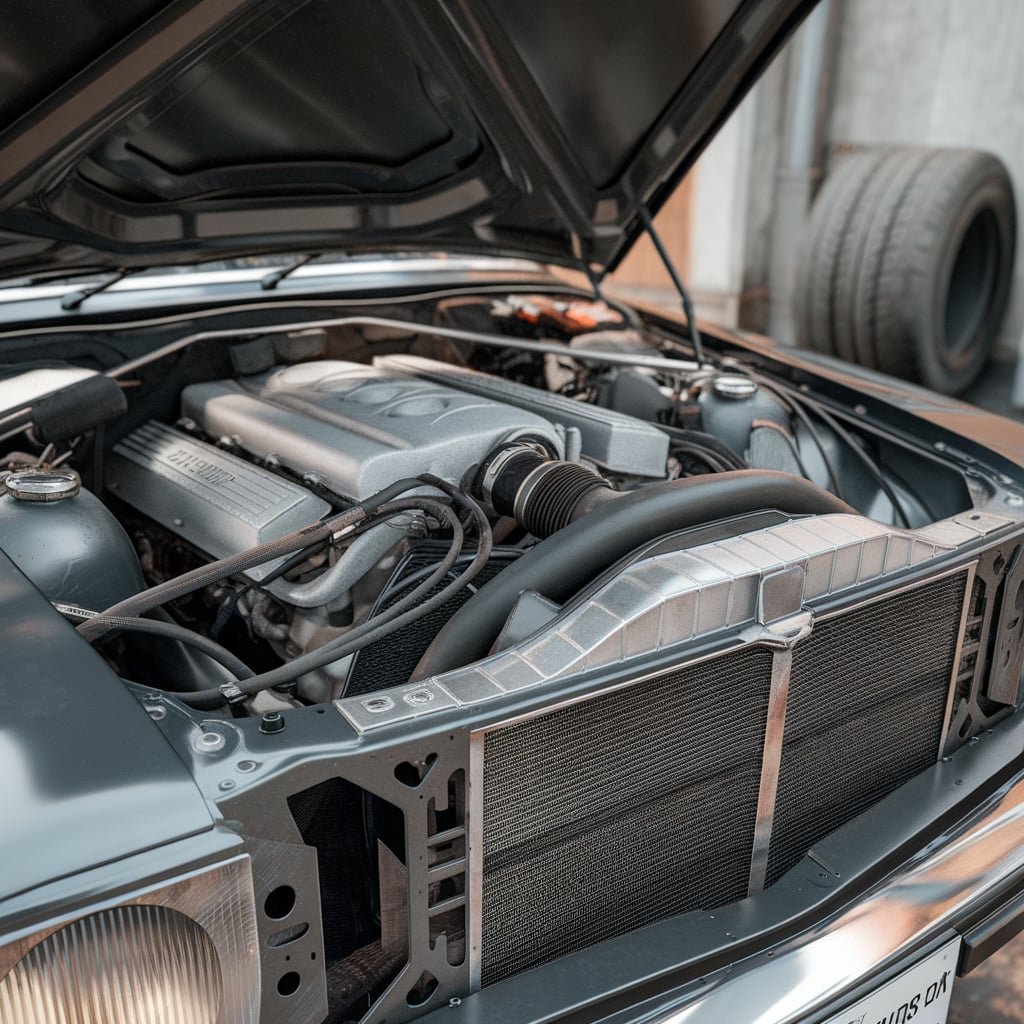
Other Cooling System Parts We Inspect During Radiator Replacement
During every Mercedes Benz radiator replacement in Dubai, we also check other important cooling parts. This helps prevent overheating and protects the new radiator from early damage.
- Radiator Hoses and Clamps
We inspect the upper and lower hoses for cracks, swelling, or softness. Weak hoses can burst or collapse, especially under high pressure. We replace any worn-out clamps to avoid leaks. - Thermostat and Coolant Sensor
A faulty thermostat can block coolant from flowing into the radiator. We check its response time and test the coolant temperature sensor through our STAR diagnostic tool. - Coolant Expansion Tank and Radiator Cap
We look for cracks or discoloration in the tank and test the cap’s pressure rating. Most Mercedes radiator caps are set to 1.2–1.5 bar. A weak cap can cause coolant to boil early. - Cooling Fan and Control Module
If the fan does not start at the right time, the engine will overheat even with a new radiator. We test fan speed and relay signals using Mercedes diagnostics.
Checking these parts ensures your Mercedes cooling system works as it should after the radiator is replaced, giving you reliable performance in Dubai’s extreme heat.
Book Your Mercedes Radiator Replacement in Dubai
If your engine temperature keeps rising or you notice coolant leaks under your Mercedes, it may be time for a Mercedes radiator replacement in Dubai. Ignoring these signs can lead to serious engine problems, especially in the heat and traffic conditions of the city. At our garage, we use only OEM or genuine Mercedes radiators, and refill the system with G48 Mercedes, approved coolant to restore factory level cooling performance. Our technicians also run complete diagnostics using the Mercedes STAR system to ensure the radiator is the real issue before starting any work.
We offer same-day radiator replacement for most models including C, Class, E, Class, GLC, and AMG variants. The service includes coolant drain, system flush, radiator installation, and full system bleeding, all done within 3 to 4 hours. Book your radiator service now to receive 10% off labor charges and a free coolant flush (AED 350 value). Contact us by phone, WhatsApp, or through our online booking system and we will confirm your appointment based on your car’s model and needs.
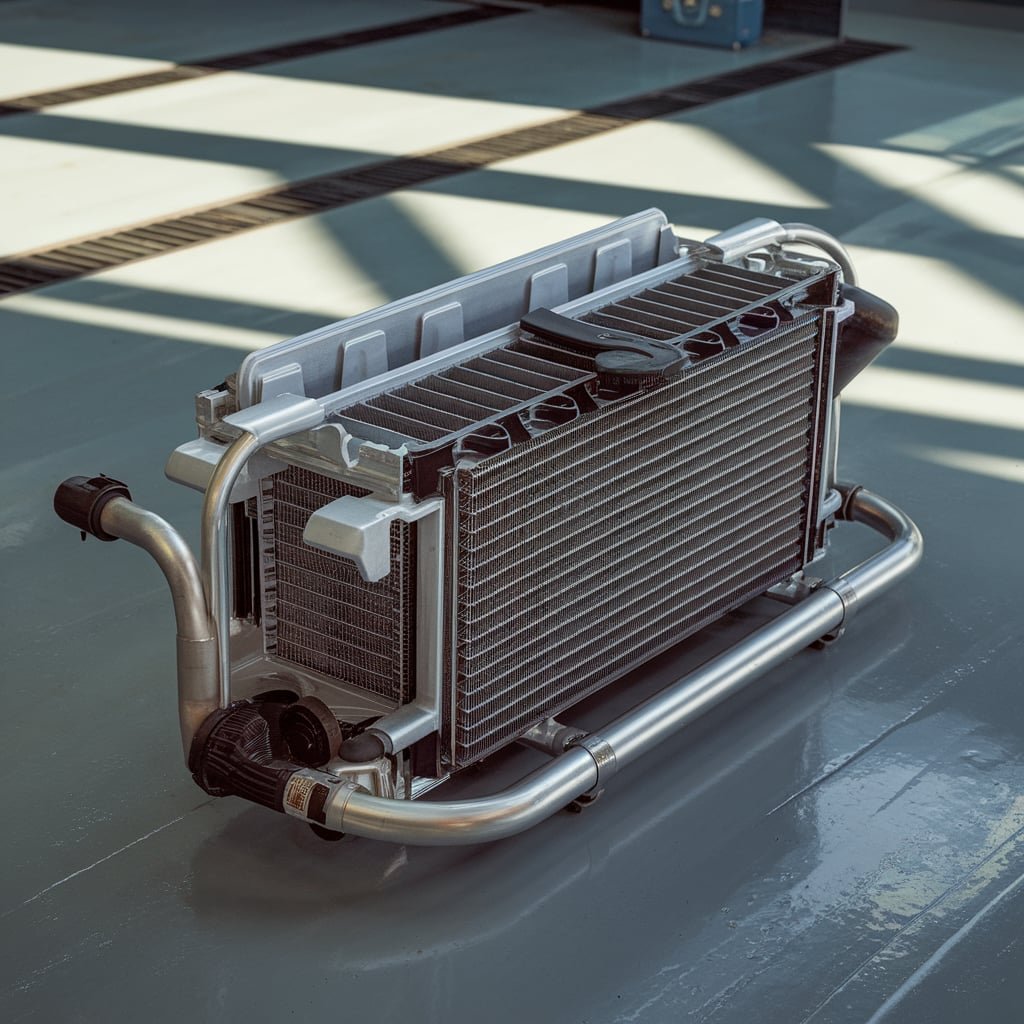
FAQs About Mercedes Radiator Replacement in Dubai
On average, a Mercedes radiator should last between 7 to 10 years, but in Dubai’s extreme heat and heavy traffic conditions, wear can occur earlier. High engine loads, frequent AC use, and poor-quality coolant can reduce its lifespan. We recommend inspecting the cooling system every 60,000 to 80,000 km and replacing the radiator if any signs of internal blockage, leaks, or overheating are found.


